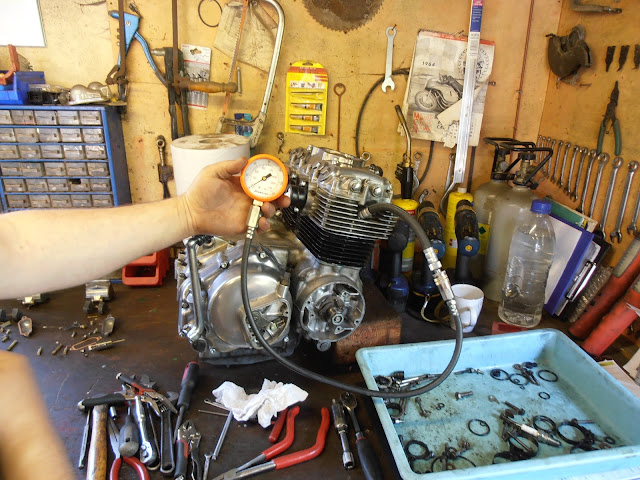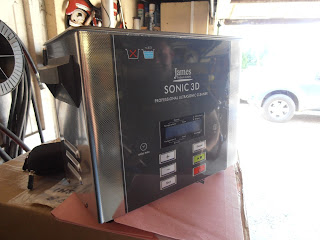For those of you who are restoring a
classic bike you may be very jealous of my recent visit to Norfolk. Based on my experience of Norfolk I was half
expecting the bike to have 3 wheels (tongue in cheek there) but in fact the
bike had the 2 wheels (and 2 very nice ones indeed) and the bloke restoring it
was a very lovely chap called Steven Last.
Steven has restored a few CB400Fs for DavidSilver Spares. He has been working with
bikes for many years and I just love his story of how he got involved in them. His father used to ride bikes at Speedway and
he was bought an Italiajet when he was
just 6 years old. His dad also used to
drive bulldozers for a living and on the weekends he would be working on the
Dozers and the bikes so Steven would always join in and work with him. Reminds me of that song “I’m Luke I’m 5 and my Dad’s Bruce Lee, drives me round in his JCB” - take a few minutes to watch this now if you haven't seen it yet, well worth it. My own middle son is forever with his dad in
his garage (I almost wrote “our” garage then but I know my place).
Steven went on to work for Honda travelling
around the world working on Hondas and Triumphs, mainly working on recall
projects. Sounds glamorous but he says
not – no sooner had you touched down in Japan that you were off again to New
York, etc. You can’t see the world from
a hotel room.
During my visit to Steven’s workshop he was
mucking out a set of carburetors on a CB400F, which had been in hundreds of
pieces yesterday. He explained that on
such an old bike the carbs get filled up with sediment and petrol and that the
bike he was working on looked like it had been kicked around the floor. The mounting surface had to be like glass;
flat and perfectly clean (so he was “having the head skimmed”). Steven was really kind to me the whole time I
was there. I was clearly a fish out of
water so he explained things really well to me.
I have been an IT tutor for many years and when delivering a Level 1
course we were trained to always assume zero knowledge but in such a way as to
not insult the student’s intelligence.
Steven was perfect in this and I really did learn a lot.
All the pieces from the carbs were lying on
the work surface in a very organized way, all ready to be cleaned. The carbs were stripped completely down to
the emulsifying jets. Steven emphasized
on many occasions how every piece of the bike had to be spotless for things to
work. His first job with any restoration
is to strip everything down to bare bones and clean everything to within an
inch of its life. Later he would put
everything back together again and get it back in the bike (with his dad’s help
with lifting) and see if it all works.
The bike he was working on was a non-starter. So what if the bike doesn’t work once all
this work is done? “It will work, it’s
all in the preparation”.
The number 1 cylinder head on this bike was
dead. How did he know this? Again, you must assume no knowledge without
making the student feel stupid, remember?
Steven explained that he uses a compression tool in the spark plug and
he could see that number 1 was dead.
Yhe, but how do you know that it was number 1? He patiently repeated “with the compression
tool”. I still wasn’t getting it – how
do you know it wasn’t number 2 or 3? So
Steven pulled out the spark plug and plugged in the compression tool and showed
me – I am very embarrassed to say that I still didn’t get it. I did feel a little stupid but I just
couldn’t see it – then I did. Each
cylinder has it’s own spark plug – doh!
Now at this point I could quickly move on to another discussion but no,
I am not very good at brushing over things.
I just said out loud “how stupid am I”?
Next we looked at the cooling fins. I was slightly aware of these from Ian Fife’s
write-up and I know that he had to repair a cracked fin. Steven showed me where the fins on this bike
had to be repaired – you could hardly see any repair and what you could see
would be sprayed so it would then be invisible to the naked eye.
Somebody had sprayed the fins black and Steven was planning on getting all this back to silver. It's amazing how handy a hairdryer can be in the workshop.
So how far do you go with these
restorations? If you are restoring a
bike out of passion, a love affair if you like, then I guess you are not really
going to worry too much about margins.
However, DSS are restoring these bikes to sell on to enthusiasts so
margins are very important. Repairing
this broken fin cost about £70; not a great deal and this was essential
work. But what about the frame? Do you send it off to be grit blasted and
powder coated or do you clean it to a perfect condition and lacquer it? You can spot fix any obvious signs of wear
like flaked paint before painting and you can make it look like a brand new
frame still. The last bike Steven
worked on was cracked where the side stand came up so he had to weld it, sand
it and then paint it before lacquering.
Every bit of the bike has to be spotless,
Steven couldn’t stress this enough: it’s all in the preparation. So what is his secret? Cillit Bang! Spray it into the carbs and jets
and what the dirt go bang (you have to shout that out very loud like Barry
Scott). He does have all the other professional
gear as well like a….well….I can’t remember what they are so just look at the
pictures.
The wheels are a very important part of any
bike I feel; from a cosmetic point of view.
You see crap wheels and there is a distinct turn off of any vehicle bike
or car. The wheels on this CB400F have
been respoked. The old ones were full of
red rust. The wheels themselves are
original but they are a little pitted in places but what do you want; the
original wheels or a replicated replacement?
It was a really great day at Steven’s
workshop and I learned so much more than just looking at photos. I have learnt that restoring bikes is not
about replacing worn out parts with new, it’s about restoring the parts that
you have as best as you possibly can to its original condition. Sometimes replacing things is inevitable
(like spokes) but mostly things can always be put back to their original
condition with a bit of love, time and maybe a bit of Cillit Bang.
I asked Steven what bike he rides now. “I don’t – I’m too mad”. This reminds me of the greats like John
McGuinness and Carl Foggerty who say that every rider has a line and it comes
down to how often you want to cross it.
Crossing it makes you a winner but sometimes you just have to look home
to your partner and kids and decide whether crossing that line is worth the
risk. For Steven he has decided that
it’s not, almost like he can’t trust himself on a bike. “Anyway horses are more
dangerous” he says. “My sister had
horses and they have minds of their own.
At least bikes have brakes”. So true (although he does have a 2002 CR250
tucked away in the garage in bits for a future day).






































